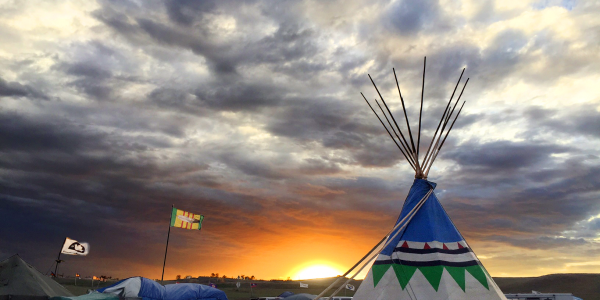Lessons from Standing Rock

There is an unprecedented movement happening in North Dakota right now. Native Americans tribes have banded together in an effort to stop the Dakota Access Pipeline, which threatens sacred sites and water supplies of the Standing Rock Sioux tribe. Mainstream media has all but ignored it, except for when protectors were attacked over Labor Day weekend. Journalists who have covered the goings on have been threatened repeatedly by local authorities.
We caught up with Kailey Luzbetak, who is an Environmental activist and graduate student at the University of Utah to get an idea of what’s going on and how we can help. Kailey studies environmental justice and social movements. Last weekend, she headed out to the campsites in North Dakota to join the protest and show her support.
Q: Kailey, you spent last weekend at the North Dakota Pipeline Access protectors site. Can you tell me what made you decide to go?
A: Some friends and I had admittedly been talking about going for quite some time now, but the logistics of getting from Utah to North Dakota made it easy to continually push the trip back. Finally, I ended up meeting a man from Iowa who had just visited the Sacred Stone Camp. A brief conversation with him proved to me that it was essential we go and support the communities there.
Q: What is the feel of the camps? How many people are there and how are protectors spending their time?
A: Gauging numbers was almost impossible because there was a constant flux of people coming in and out, and the tents and tipis were really comfortably spread out. Our guess was about 6,000 [people], and it seems the media is saying something around that number too. The feel is… Difficult to describe. Humbling, comforting, inspiring.

Q: Why have the protectors chosen to be called “protectors” instead of “protesters”. Does this slight change in wording make a difference in the feel of the camps?
A: I shouldn’t speak for the native people who began the camp because I’m not sure if that language choice was strategy-based or not, but if I had to guess, I’d bet it’s simply a difference in mindset. Or that’s the impression I got while I was there, and based on the things that were said to me, anyway. It seems that the people who are camping out don’t view what they’re doing as a protest, but as an obligation to protect this land and water — for its intrinsic value, for the species that live with it, for the future people who will also live with it.
Q: What, if anything, did your time there teach you about environmental activism and advocacy?
A: To listen. And then listen some more.

Q: Where does the fight stand now and how can non-Native American advocates help?
A: [U.S. President] Obama put a temporary halt on construction of the DAPL on federal lands and adjacent properties, but [the corporation] Energy Transfer is not going to give up so easily. Non-natives can do two things that would be hugely helpful:
1. Donate goods that will help protectors winterize their camp. People have every intention of holding that space until the pipeline is permanently and officially called off. North Dakota can have some cold winters — that means winter tents, heavy duty sleeping bags, jackets, boots, and cooking supplies that will hold up in low temps. Reach out to the camp via Facebook if you’re looking to organize a donation.
2. Don’t let this conversation fade away. Keep talking about it, keep sharing stories on social media, keep putting pressure on the president and local authorities to do the right thing here. What Energy Transfer would like is for this to effort to die out quietly, and the media to ignore it. Don’t let this happen.
Q: I’ve been really impressed with how one tribe stood up and then so many others joined. Do you think it was the movement in general or the way in which the first tribe stood their ground that has made others want to join them?
A: Again, I think my view of the whole thing is quite privileged and I honestly don’t know how Sacred Stone Camp became this mecca of sorts for native people around the world. But what is so wild is that as nearly every tribe formally entered camp (most said a few words, many offered traditional gifts) they mentioned a pipeline, or a fracking site, or an oil spill, or any number of environmental issues that they too were facing. Standing Rock Sioux Tribe is just one example of [one tribe that is fighting] an outright environmental war on indigenous lands. I think that is why the solidarity has come so naturally among thousands of native people — because it’s something so many of them are facing at home.
Q: Can you tell me about the press coverage? It seems we were hearing a lot about this for a while and then not much lately.
A: I’m sure there was coverage that I didn’t see — the camp is quite big — but the whole time I kept thinking, “This is history. Why is no one watching?” My experience with the coverage has been the same as yours, and it’s incredibly frustrating. I watched people enter the camp from the Laplands in Sweden, the Amazonian rain forest of Ecuador — that man in particular had to canoe many miles, then got on a bus, then got on a plane, then rode here in a car if I remember correctly. The solidarity is incredible, and it should be… Everywhere. Everyone should know about this.
Kailey’s right. It’s time that everyone heard about this movement to fight back against corporate interests that want to poison our water and disenfranchise thousands of native peoples in the U.S. Tell us in the comments what you’re going to do to help.
